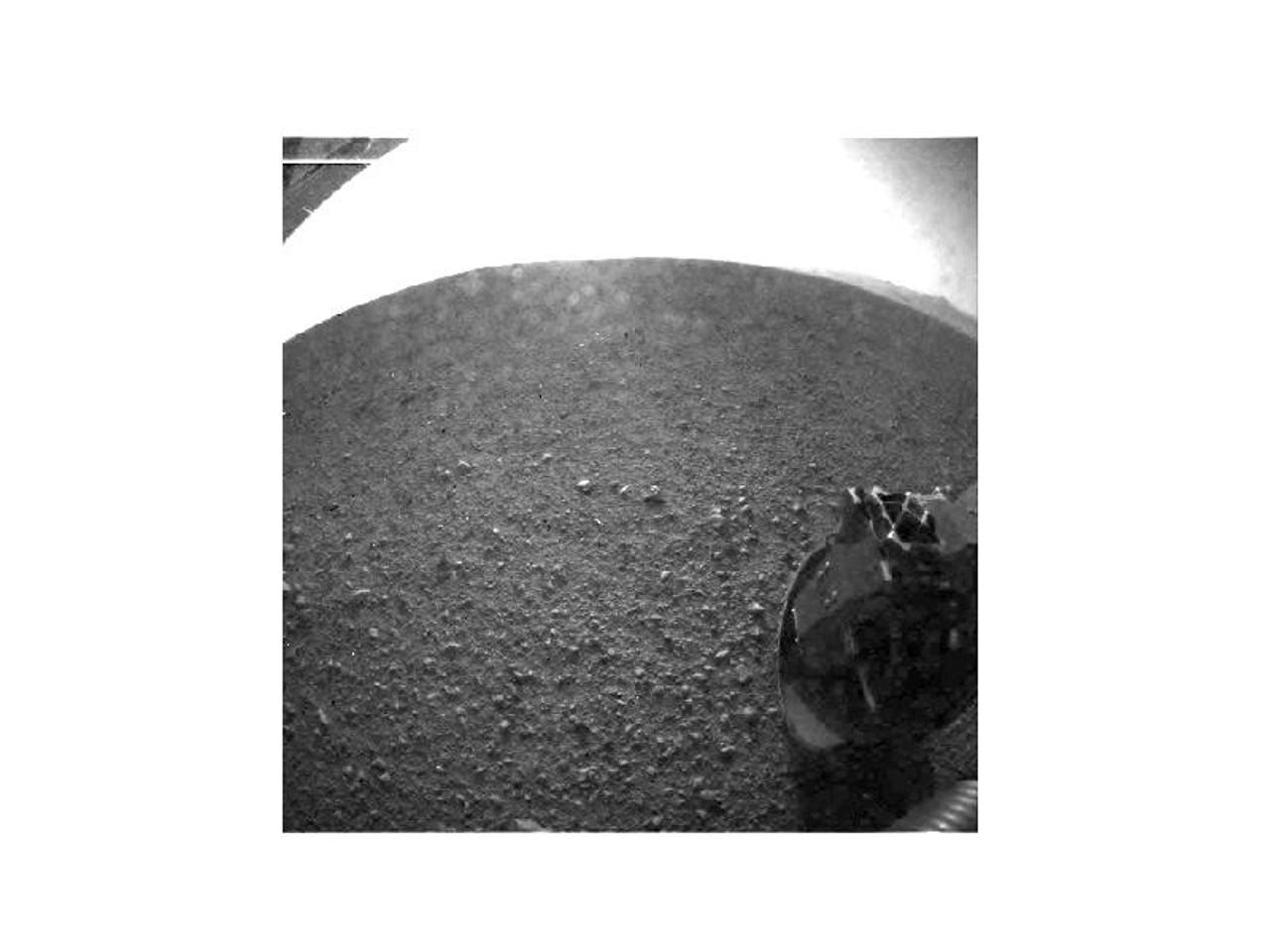Curiosity lands on Mars! (photos)
Some of the first photos NASA's Mars rover, Curiosity, took after it touched down at 1:32am EDT. Plus, images of the landing spot and celebration at NASA.


1 of 16 Laura Shin/ZDNET
One of Curiosity's first photos from Mars. (NASA/JPL-Caltech)
This post was originally published on Smartplanet.com
2 of 16 Laura Shin/ZDNET
Artist's conception: Curiosity examines a rock on Mars with a set of tools at the end of the rover's arm, which extends about 7 feet. (NASA/JPL-Caltech)
This post was originally published on Smartplanet.com
3 of 16 Laura Shin/ZDNET
Curiosity's shadow (NASA/JPL-Caltech)
This post was originally published on Smartplanet.com
4 of 16 Laura Shin/ZDNET
Engineers at NASA's Jet Propulsion Laboratory in Pasadena, Calif., celebrate the landing. (NASA/JPL-Caltech)
This post was originally published on Smartplanet.com
5 of 16 Laura Shin/ZDNET
As the rover descended toward Mars, it communicated basic radio-frequency tones directly to Earth (pink dashes) and more complex UHF radio data (blue circles) that required relaying by orbiters. (NASA/JPL-Caltech)
This post was originally published on Smartplanet.com
6 of 16 Laura Shin/ZDNET
In June, NASA narrowed down the landing target for Curiosity from the wider, fainter circle seen here to the darker, narrower circle. (NASA/JPL-Caltech)
This post was originally published on Smartplanet.com
7 of 16 Laura Shin/ZDNET
NASA divided up the landing zone (in red) and the adjacent area into quadrangles. (NASA/JPL-Caltech)
This post was originally published on Smartplanet.com
8 of 16 Laura Shin/ZDNET
This weather map of Mars was taken Aug. 4, 2012 to forecast weather conditions for Curiosity. The atmosphere was clear and seasonal around Gale Crater. (NASA/JPL-Caltech)
This post was originally published on Smartplanet.com
9 of 16 Laura Shin/ZDNET
This image shows changes in the target landing area for Curiosity. The larger ellipse was the target area prior to early June 2012, when the project revised it to the smaller ellipse centered nearer to the foot of Mount Sharp, inside Gale Crater. (NASA/JPL-Caltech)
This post was originally published on Smartplanet.com
10 of 16 Laura Shin/ZDNET
Gale Crater on Mars, where Curiosity landed, belongs to a family of large, very old craters shown here on this elevation map. It has one of the lowest elevations among this family. (NASA/JPL-Caltech)
This post was originally published on Smartplanet.com
11 of 16 Laura Shin/ZDNET
This graphic shows the locations of the cameras on Curiosity. The rover's mast features seven cameras: the Remote Micro Imager, part of the Chemistry and Camera suite; four black-and-white Navigation Cameras (two on the left and two on the right) and two color Mast Cameras (Mastcams). (NASA/JPL-Caltech)
This post was originally published on Smartplanet.com
12 of 16 Laura Shin/ZDNET
The Sample Analysis at Mars (SAM) instrument for NASA's Mars Science Laboratory mission will study chemistry of rocks, soil and air as the mission's rover, Curiosity, investigates Gale Crater on Mars. SAM was built at the NASA Goddard Space Flight Center, Greenbelt, Md., where this image was taken. (NASA/JPL-Caltech)
This post was originally published on Smartplanet.com
13 of 16 Laura Shin/ZDNET
This image illustrates the principles of a technique called "laser-induced breakdown spectroscopy," which the ChemCam will use on Mars. The technique fires pulses of a laser at a target such as a rock. Energy from the laser excites a pinhead-size spot on the target into glowing, ionized gas called plasma. Spectrometers in the instrument analyzes the spectrum of light emitted by the plasma to identify chemical elements in the target. (NASA/JPL-Caltech)
This post was originally published on Smartplanet.com
14 of 16 Laura Shin/ZDNET
Detail observed from 10 feet away with Curiosity's ChemCam. (NASA/JPL-Caltech)
This post was originally published on Smartplanet.com
15 of 16 Laura Shin/ZDNET
The launch of Curiosity on November 26, 2011 from Cape Canaveral Air Force Station. (United Launch Alliance)
This post was originally published on Smartplanet.com
16 of 16 Laura Shin/ZDNET
The Mars Science Laboratory team celebrating after Curiosity landed and began sending back images. (NASA/Bill Ingalls)
This post was originally published on Smartplanet.com
Related Galleries
Holiday wallpaper for your phone: Christmas, Hanukkah, New Year's, and winter scenes
![Holiday lights in Central Park background]()
Related Galleries
Holiday wallpaper for your phone: Christmas, Hanukkah, New Year's, and winter scenes
21 Photos
Winter backgrounds for your next virtual meeting
![Wooden lodge in pine forest with heavy snow reflection on Lake O'hara at Yoho national park]()
Related Galleries
Winter backgrounds for your next virtual meeting
21 Photos
Holiday backgrounds for Zoom: Christmas cheer, New Year's Eve, Hanukkah and winter scenes
![3D Rendering Christmas interior]()
Related Galleries
Holiday backgrounds for Zoom: Christmas cheer, New Year's Eve, Hanukkah and winter scenes
21 Photos
Hyundai Ioniq 5 and Kia EV6: Electric vehicle extravaganza
![img-8825]()
Related Galleries
Hyundai Ioniq 5 and Kia EV6: Electric vehicle extravaganza
26 Photos
A weekend with Google's Chrome OS Flex
![img-9792-2]()
Related Galleries
A weekend with Google's Chrome OS Flex
22 Photos
Cybersecurity flaws, customer experiences, smartphone losses, and more: ZDNet's research roundup
![shutterstock-1024665187.jpg]()
Related Galleries
Cybersecurity flaws, customer experiences, smartphone losses, and more: ZDNet's research roundup
8 Photos
Inside a fake $20 '16TB external M.2 SSD'
![Full of promises!]()